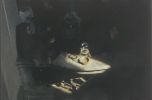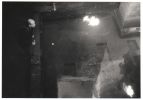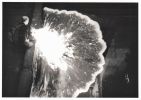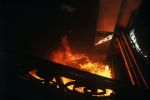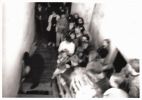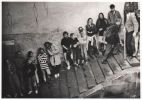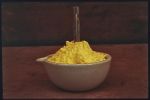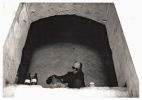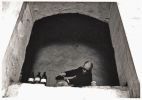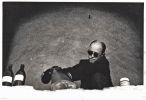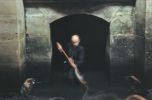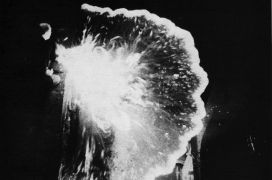Hommage to:
1. Jan Blažej Santini: (water basin, fire)
2. František Xaver Messerschmidt: (chapel of St. Benedict, mirror, sulphur)
3. Athanasius Kircher: (cellar, aqua regia)
"The forms of presentation correspond to the mannerisms of the times, the link with the Rudolphinian tradition is essential.
Thus – elementary demonstration – still
Meantime – a mirror’s shattering – filling the temple's emptiness
On-to-logical touches It (which changes and lasts)
to see – to will – to dare – to be silent"
Tomáš Ruller, 1993
Tomáš Ruller structured his contribution to the festival in three sections, leading the group to different locations of the convent:
1. Hommage to J.B. Santini consisted of an alchemical process of meeting of the elements of fire and water (burning spirit on the surface of a water basin on the convent's ground floor).
2 Hommage to Franz Xaver Messerschmidt: Performance in the chapel of St. Benedict with a small hand-held mirror, Ruller mimmicking the extreme facial expressions of Messerschmidt's sculptures.
3. Hommage to Athanasius Kircher consisted of inviting the visitors to the dark, desolated part of the convent in the basement and breaking in a blocked door with an iron crowbar, opening the hidden "shelter" under the floor.
Hermetism and alchemy were an important inspiration of Ruller's work during the 90s.
The concept of Hermit appealed to me from the very start. I was interested in the hermetic ideas and, with the memory of the magical opening of the 9&9 photography exhibition in 1981 etched deep in my memory, I chose a reference and tribute to three personalities : J. B. Santini, A. Kircher and F. X. Messerschmidt, while also drawing inspiration from lectures during the symposium.
Three in One… a situational event was organised like a procession; we essentially made a ring in the building of the cloister with three stops. With each one, I started in an empty space, left certain traces in it as remnants of the intervention, and at the end gradually cleaned them up, in this way to create ‘temporary installations’. The primary element of the design of architect J. B. Santini here was water penetrating into the interior and reflecting the light entering from outside.
1. First event near the main staircase, on the stone railing above the water mirror: I placed two spherical flasks resembling alembics (1) on top of each other in the sunlight. As we descended below the staircase towards the water’s surface, I took a match and ignited the invisible film of flammable substance on it. Immediately a flame shot out of the water and a blaze arose – many of the viewers stepped back towards the damp walls – the flame enlighted the staircase before almost instantly fading away. A powerful experience was produced by the unanticipated combination of opposing elements and especially by the strength of fire.
2. We then quietly walked through the corridors of the cloister to the Chapel of Saint Benedict, where I made sound with the ringing blows of a heavy metal crowbar on the stone tiles, my own voice along with the creaking of pews and doors, the shuffling of shoes and the voices of the people present, the flutter of birds’ wings outside and other random ambient sounds. I then ceremoniously placed a bowl with yellow sulphur on the altar, inserted a mercury thermometer into it, and stepped beneath the high altarpiece. In front of it and in front of the audience, in slow motion and holding in hand a triangular mirror in which everything and everyone was reflected, I began mimicking Franz Xaver Messerschmidt’s canonical grimaces.
3.When I was walking around the cloister beforehand to prepare the piece, I was banging with a pole on the floor and came across a hidden cavity space unknown to the participants of the event. With the same ringing, as if carrying a shepherd’s staff, I led the audience to that place, where with a terrible cracking of planks and creaking of nails, I pried open the hatch to the unused cellar. On the raised landing of the spiral staircase with an arched window, I then mixed aqua regia in a glass flask and, performing a ‘test of purification’, I dropped my gold wedding ring into it. The object with the chemical process in progress, which I dedicate to Athanasius Kircher I carried into the stalker-ravaged room, from where I then escaped on a ladder through a hole in the wall and out into the light. As the departing participants passed by the water pool, they saw me there skimming the powder cleaner with the absorbed waste off the surface of the water.
II.
I consider the Plasy symposiums, which were rooted in the tradition of alternative art, to be some of the most important activities of the 1990s. After 1990, most local artists aligned themselves with official positions, while this was one of the few activities not aimed towards the established context. Although it was supported by grants, it retained the atmosphere of events held during the 1980s. Unlike most of us, who finally tried to breathe in the world after the collapse of the Iron Curtain, Miloš, returning from abroad, and his colleagues invited important individuals from Europe and various corners of the world. An experimental centre, anchored in current lively international activity was created.
The list of names on the documentation website indicates that it wasn’t a random group of people who happened to be around and who tried something here, but a curated choice of personalities, by no means a hermetically sealed community, representing the current international scene at the time. Quite the opposite – it was an open gathering where everybody was welcome. But the truth is, most of the people who came there were aware where they are going and what they are getting into. Such an alternative is necessary so the established sphere can be renewed, enriched, and new impulses created. The alternative is also related to a way of living, not only to the world of art, let alone art ‘operations’. There was a deeper kinship here than beyond a formally artistic one, because the people who came together were based primarily on their opinions, or on their search and verification.
The name Hermit itself was refering to silence, meditation; it was based on an alternative to the hectic career world of the contemporary art and on the search for other, rather inner, roots tied to tradition. The monastery’s atmosphere had amazing meditative potential. This was art that focused not on production, but on experience, basically on ephemeral forms tied to a place, to the genius loci of the site. Even the environment itself attracted people and absorbed work, which found fertile ground for further development there. Miloš talking about metamedia and the spirituality of space led more to mental and spiritual work. The place itself became the medium, and the medium was even the entire structure as it unfolded – meeting and creating a space for communication, the way we shared experiences. This deeper affinity was the most valuable thing about Hermit. The uprooting that we had to deal with after the fall of the socialist system and actually after the disintegration of the underground; the opposition and all structures were balanced, creating an acute need to search for new foundations. It was a place for the clash of opposing forces and ideas that attracted and repelled, phenomena that require both perceptiveness and spontaneity. Not only the devastation of virtually all the values inscribed there from the totalitarian era, but also the fact that the Baroque monastery building stands on swamps was awe-inspiring. It was eloquent and stimulating.
Snippets from interview with Radka Schmelzová from January 2007
Tomáš Ruller (born 1957 in Brno) is a Czech visual artist and performer. He graduated in 1982 from Akademie výtvarných umění, Prague (Department of Sculpture) and devotes his efforts to creating in real space and time. He puts together multimedia performances, installations, videos, architectural realisations and travelling theatrical shows. The first phase of his work falls into the era of the Communist regime, when he often came into conflict with government authorities and was forced to realize his projects in unofficial spaces. He studied classic sculpture, which at the time was the only official option for realizing artistic works in 3D space. However, his works were otherwise quite removed from this traditional field. He became acquainted with current trends in Western art, whose artistic creations he often understood not to be as the production of artefacts, but rather as a time-space, mental event. The piece’s message comes from its incompleteness, its fragmentation and its scenic qualities. The artist uses similar methods elsewhere. He gradually begins to test technical media, photographs, and video. These resources serve not only for recording, but he also uses them during the events themselves. The medium’s timing is also important. The author is, as a rule, the promoter of his own events (in the spirit of body art). His messages can appear to be timely, perhaps even political, but they mainly concern basic questions of an ontological nature. It is in this way that Ruller’s creations call to mind alchemic or cabbalist concepts.
Václav Hájek, taken from the web (edited)
http://www.artlist.cz/en/tomas-ruller
